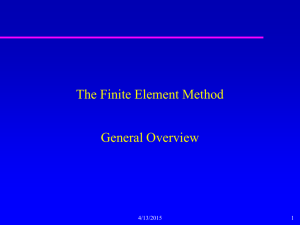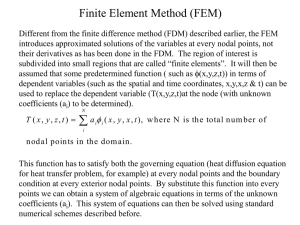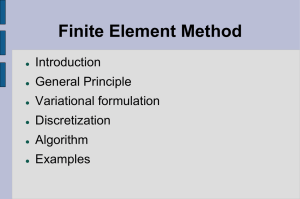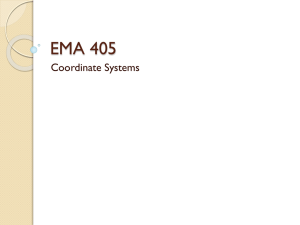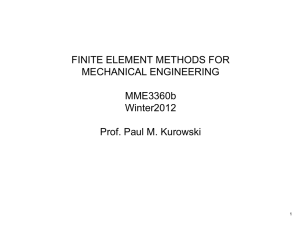Classification: -- - School of Civil & Environmental Engineering
advertisement
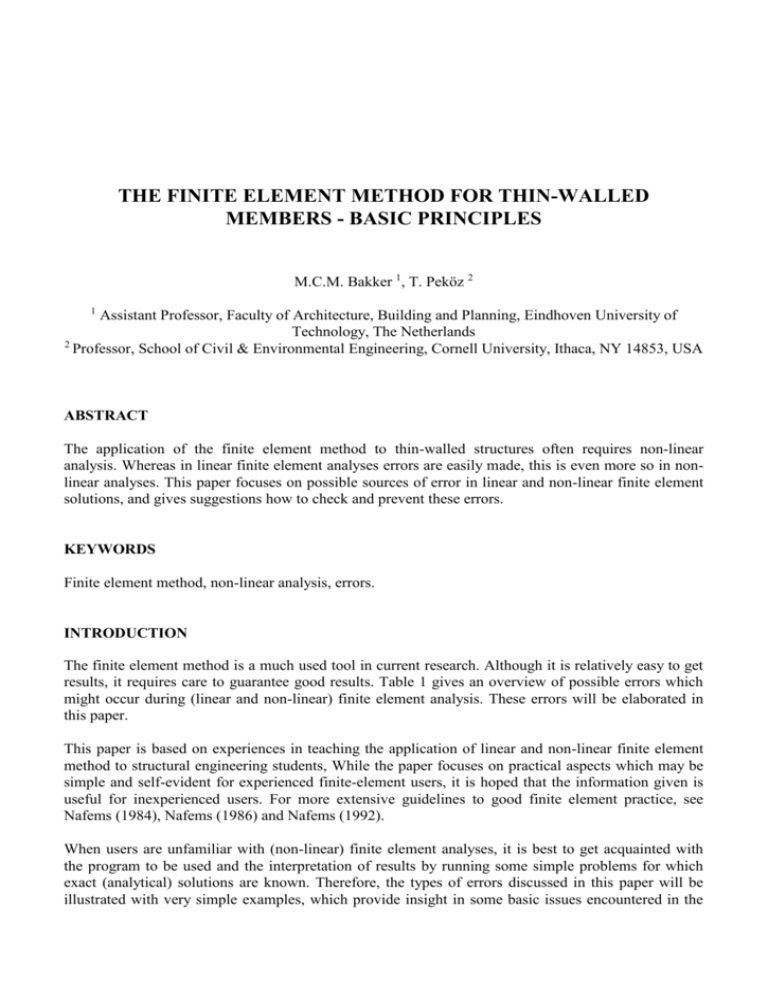
THE FINITE ELEMENT METHOD FOR THIN-WALLED MEMBERS - BASIC PRINCIPLES M.C.M. Bakker 1, T. Peköz 2 1 Assistant Professor, Faculty of Architecture, Building and Planning, Eindhoven University of Technology, The Netherlands 2 Professor, School of Civil & Environmental Engineering, Cornell University, Ithaca, NY 14853, USA ABSTRACT The application of the finite element method to thin-walled structures often requires non-linear analysis. Whereas in linear finite element analyses errors are easily made, this is even more so in nonlinear analyses. This paper focuses on possible sources of error in linear and non-linear finite element solutions, and gives suggestions how to check and prevent these errors. KEYWORDS Finite element method, non-linear analysis, errors. INTRODUCTION The finite element method is a much used tool in current research. Although it is relatively easy to get results, it requires care to guarantee good results. Table 1 gives an overview of possible errors which might occur during (linear and non-linear) finite element analysis. These errors will be elaborated in this paper. This paper is based on experiences in teaching the application of linear and non-linear finite element method to structural engineering students, While the paper focuses on practical aspects which may be simple and self-evident for experienced finite-element users, it is hoped that the information given is useful for inexperienced users. For more extensive guidelines to good finite element practice, see Nafems (1984), Nafems (1986) and Nafems (1992). When users are unfamiliar with (non-linear) finite element analyses, it is best to get acquainted with the program to be used and the interpretation of results by running some simple problems for which exact (analytical) solutions are known. Therefore, the types of errors discussed in this paper will be illustrated with very simple examples, which provide insight in some basic issues encountered in the modeling of thin walled structures. In these examples, only beam and truss elements are used, but similar results can be found when running the examples with shell elements. The finite element method is an approximate method in which equilibrium and/or compatibility conditions may be approximated. This paper will limit the discussions to finite element programs in which only equilibrium is approximated. TABLE 1 OVERVIEW OF POSSIBLE ERRORS Reality Idealization error Mechanics model Input error Discretization error: equilibrium approximated Geometry error: geometry aproximated Shortcomings in element formulation Program bugs Finite element model Solution error Convergence error Program bugs Nodal displacements Program bugs Derived results according to FE model Rendering error: postprocessor inter/extrapolates differently than FE model: integration points nodes contour plots Program bugs Results according to postprocessor Interpretation error: postprocessor shows something else than is expected, for instance averaged instead of unaveraged stresses Interpretation of resuls PREPROCESSING SOLVING POSTPROCESSING IDEALIZATION ERRORS Choosing a mechanics model Idealization errors are errors caused by a wrong idealization of the real structure, loads and supports to a mechanics model. When a structure is idealized by a mechanics model one has to decide: - the mechanical approach needed to describe the behavior, e.g. beam theory, shell theory or 3D stress theory. This choice implies how the geometry of the structure will be described, namely as a line, a plane or a solid. - assumptions that may be made regarding the magnitude of deflections, strains and rotations. This determines what type of geometrical non-linear analysis should be run. - how the material behavior may be idealized. - whether the influence of initial stresses should be accounted for, and how these residual stresses are distributed through the model. - - how accurately the geometry of the structure must be modeled in order to get accurate results. Magnitude and distributions of deviations from the ideal geometry (initial imperfections) must be considered. how loads and supports should be modeled. When idealizing a structure it is important to know what one wants to learn from the mechanical model. The objective is not to describe reality as accurately as possible, but to find the simplest model resulting in a sufficiently accurate description of reality. Unfortunately, this will often require a lot of insight in the behavior of the structure. In case it is found necessary to build a very sophisticated model, it is best to start the analysis with a simple model, and use a step by step approach to increase the complexity of the model. The choice of the kind of mechanics needed (corresponding to the choice of the type of element) and the appropriate modeling of material properties, initial stresses and initial imperfections are discussed in an accompanying paper by Sarawit, Kim, Bakker and Peköz. Only the types of nonlinear analysis will be discussed here. Types of geometrical non-linear analysis With respect to geometrical non-linear behavior a distinction can be made between first order analysis, second order analysis, a large deflection analysis, a large rotation analysis, a large strain analysis and an eigenvalue buckling analysis (see Table 2, and Figure 1). The well known first order analysis is a geometrical linear analysis, in which equilibrium is formulated with respect to the undeformed shape. In the other, geometrical nonlinear types of analysis equilibrium is formulated with respect to the deformed state. A second order analysis accounts for stress stiffening effects (P- effects). In a large displacement analysis membrane stresses developing due to out of plane deflections can also be described, but rotations and strains still have to be small. A large strain analysis is the most general geometrical non-linear analysis, in which neither strains, nor rotations or displacements need to be small. A large strain analysis is the only type of analysis in which changes in thickness or area are accounted for. TABLE 2 TYPES OF GEOMETRICAL NONLINEAR ANALYSIS Type of analysis First order (linear) Second order (stress stiffening) Large displacement Large rotation Large strain Displacements Very small Small (negligible membrane stresses due to out of plane deflections, displacements smaller than the thickness of the beam/plate/shell) Large (significant membrane stresses due to out of plane deflections, displacements larger than the thickness of the beam/plate/shell) Large Large Rotations Very small Small ( 100 ) Strains Small ( 5%) Small ( 5%) Small ( 100 ) Small ( 5%) Large Large Small ( 5%) Large An eigenvalue buckling analysis is a special kind of geometrical non-linear analysis. Usually it is based on a second order formulation. Using the assumption of linear load-deformation behavior up to the attainment of the buckling load the factor with which the loads on the structure should be multiplied in order to get a non-unique solution (the eigenvalue) can be determined. For some structures the load determined by this analysis represents the buckling load of the structure. However, if prebuckling deformations are not small, the load determined does not have much physical relevance (see for instance the eigenvalue calculation in the structure where snap-through occurs). So one should keep in mind that an eigenvalue calculation is a mathematical trick, which can always be performed, regardless of the physical significance. In most cases a linear analysis will not give useful results for the analysis of cold-formed structures, but it is good practice to start every non-linear analysis with a linear analysis. If one wants to model the non-linear load deflection behavior of thin-walled structures, including post-buckling behavior, one needs at least a large deflection analysis or a large rotation analysis, since a second order analysis cannot describe membrane stresses develop due to out-of plane deflections. It is also possible to use a large strain analysis, but in most cases it is much simpler to use a large displacement or large rotation analysis. Note that in defining loads in a large rotation analysis (contrary to first and second order analysis) a distinction is made between follower forces (element loads), where the direction in which the loads act is dependent of deformations of the structure, and nodal loads, where the direction of the loads does not change. It is the responsibility of the user to make sure the right type of analysis is used. A finite element program does not give warnings when displacements, rotations or strains are so large that the assumptions on which the analysis is based are violated, but just gives unreliable results! INPUT ERROR Input errors are errors made in the preprocessing phase, when building the finite element model. It is best to check input errors by running a linear analysis, before starting with the non-linear analysis. Some simple checks on input error are to inspect a plot of the finite element mesh and to run a linear analysis with the model loaded by unit loads. Furthermore the material and geometry properties should be checked carefully, as well as the applied loads and boundary conditions. For more checks see Nafems (1982) and Nafems (1986). DISCRETIZATION ERRROR In the finite element method the nodal displacements and/or rotations are obtained from nodal equilibrium equations, resulting in the best approximation of the equilibrium conditions throughout the structure for the given finite element mesh. If the mesh is to coarse, the equilibrium conditions are satisfied poorly. This is called a discretization error. A discretization error can be recognized from stress discontinuities between elements. A discretization error may also be recognized at boundaries of the finite element model, where it can be observed how much calculated stresses deviate from known stresses. Furthermore, it is good practice to study the influence of mesh refinement on the results. When one builds a finite element model an important question is how dense the mesh should be for sufficiently accurate results. The required mesh density depends on the stress gradients (larger stress gradients need a finer mesh), and the question whether the mesh should result in adequate stress results, or only in adequate stiffness results. Poorly shaped quadatric elements may loose their accuracy, and thus may increase the discretization error. Poorly shaped linear elements are less shape sensitive, since both ideal shaped and poorly shaped linear element must be able to describe constant stress states. In a physical non-linear analysis (using non-linear material models) with shell elements, the discretization error is very much dependent on the number of integration points used over the area of a shell element. Due to discretization errors, the von Mises stresses in points different from the integration points may far exceed the yield stress. One should be aware, that both an eigenvalue analysis and a physical and/or geometrical nonlinear analysis require a (sometimes much) finer mesh than a linear analysis. Figure 2 illustrates this for a beam element. GEOMETRY ERROR A geometry error occurs when the geometry of a structure cannot be described exactly by the finite element mesh used. An example of a geometry error is the modeling of a beam with varying height by elements with constant stiffness properties over the length of the elements. Another example is the modeling of a curved shell with flat shell elements. A geometry error is of interest only when small changes in geometry have a large influence on the results. For the modeling of thin walled structures, the correct modeling of the corner radius might be an issue for some loading conditions (for instance web crippling). In addition, one should be aware of the fact that small changes in the shape of holes may have a large influence on the magnitude of stress concentrations. In general, a geometry error can only be checked by studying results for varying mesh densities. A geometry error does not necessarily result in stress discontinuities. The finite element analysis may result in a solution, which is in perfect equilibrium (no discretization errror), however a geometry error is present due to the use of a wrong geometry! SHORTCOMINGS IN ELEMENT FORMULATIONS When modeling physical non-linear behavior of thin–walled structures with shell elements, the number of integrations points over the thickness of the shell element is even more important than the number of integration points over the area of a shell element. Whereas a limited number of integration points over the area of a shell element may be compensated by using a fine mesh, this is not the case for a limited number of integration points over the thickness of the shell element. Too few integration points over the thickness will result in an inaccurate prediction of the moment of first yield, the fully plastic bending moment and the interaction between membrane stresses and bending moment. This type of error is called a shortcoming in the element formulation (see Figure 2) Other types of shortcomings in element formulations which might be encountered in shell elements are shear locking and membrane locking. Also one should be aware of the possibility of mesh locking due to large plastic strains (Zienckiewicz and Taylor (1991), Cook, Malkus and Plesha, (1989)). If no results of appropriate benchmark tests (as for instance published by NAFEMS) are available, one should assure oneselve that the elements to be used perform well for the intended application, by running appropriate tests. SOLUTION AND CONVERGENCE ERROR In literature on the solving of linear and non-linear nodal equilibrium equations in finite element analysis (see for instance Bathe (1982), Cook, Malkus and Plesha (1989) and Nafems (1992)), much attention is given to the discussion of solution errors, that is, errors occurring in the calculated nodal displacements due to ill conditioning of the nodal equilibrium equations and the finite number of digits the computer uses to represent floating-point numbers. In literature on non-linear analysis the emphasis in on convergence errors, that is errors occurring in the calculated nodal displacements in a nonlinear analysis due to the iterative solving of the nonlinear equations, and not much is said about the influence of solution errors. It is probable that solution errors do not directly affect the accuracy of the solution, but may cause convergence problems. Both in linear and nonlinear analysis if the equations are solved exactly, the internal nodal forces calculated from the calculated nodal displacements are in exact equilibrium with the applied external nodal forces. If the equations are not solved exactly, the internal and external residual nodal forces will not be in exact equilibrium and residual nodal forces will occur. Unfortunately, both in linear and nonlinear analysis small residual forces do not guarantee accurate displacements (and stresses), and large residuals do not necessarily imply inaccurate displacements (and stresses), see also Table 3. In linear analysis, a good conditioned set of equations and small residuals will guarantee an accurate solution. In nonlinear analysis, a combination of sufficiently tight residual force criteria and displacement based convergence criteria will guarantee an accurate solution. In other cases, engineering judgement will be needed to determine whether the solution is acceptable or not. TABLE 3 INFLUENCE OF RESIDUALS ON ACCURACY OF SOLUTION Small residuals Good condition/ small iterative displacements Small residuals Bad condition/large iterative displacements Large residuals Good condition/small iterative displacements Large residuals Bad condition/large iterative displacements Nodal equilibrium Accurate Nodal displacements Accurate Accurate Possibly inaccurate Inaccurate Possibly accurate Inaccurate Probably inaccurate RENDERING ERROR After the nodal displacements have been calculated, the displacements in the elements, and hence the stresses and strains in the elements can be calculated. One should be aware that the way in which a postprocessor presents this results does not always correspond to the results according to the finite element theory. In a postprocessor the stress distribution over an element will often be determined with a linear interpolation between the stresses in the corner nodes, regardless of the presence of intermediate nodes. Sometimes the stresses in the nodes are assigned the values of the stresses in integration points. In many cases, rendering errors will become apparent only in very coarse meshes, as may be used in simple problems to get accustomed with a program. INTERPRETATION ERROR When looking at stress results it is important to be aware whether on looks at contour plots of element stresses (unaveraged stresses) or nodal stresses (averaged stresses). Plots with averaged stresses may look much nicer but may obscure large discretization errors. Non-linear load-deflection calculations result in dots in a load-displacement diagram. Interpolating a curve through these dots, as many post-processors do, can result in erroneous results. Sharp bends in such curves should be mistrusted, until explained by the model behavior. It is especially important that a sufficiently large number of dots is calculated to determine the ultimate load, otherwise the failure load may be severely underestimated. PROGRAM BUGS Program bugs may occur in any finite element program. It is good practice to record the program version which has been used for an analysis, so that when a program bug is reported in a newsletter, it is possible to check whether the results of a certain analysis might have been affected by this bug. Program bugs are more likely to be encountered in the more exotic options of a program, for instance the application of initial stresses. Therefore when one is using a new option for the first time, it is wise to check this option first on a simple problem for which the exact solution is known. PREFERABLE ORDER IN CHECKING ERRORS 1. 2. 3. 4. Check input errors (before starting a nonlinear analysis) Check solution/convergence errors Check discretization errors Check idealization errors as far as possible (check assumptions on magnitudes of deflections, rotations and strains) 5. When one encounters unexplainable results, keep in mind that there might be errors in the element formulation, program bugs, rendering errors and interpretation errors. When comparing finite element results with experimental or analytical results, the error might also be in the experimental or analytical results! Note that stress discontinuities between elements may indicate either a solution/convergence error, or a discretization error. Therefore it is best to check solution/convergence errors before checking discretization errors. CONCLUSIONS The avoidance of errors and mistakes in finite element analysis requires a critical attitude towards the obtained results. Much care should be given to checking possible errors as discussed in this paper. REFERENCES Bathe, K.J. (1982), Finite Element Procedures in Engineering Analysis. Prentice-Hall, Inc., Englewoord Cliffs, New Jersey. Cook, R.D., Malkus, D.S. and Plesha, M.E. (1989), Concepts and Applications of Finite Element Analysis, John Wiley & Sons, New York. Nafems. (1984), Guidelines to finite element practice, Nafems, NEL, Glasgow. Nafems. (1986), A Finite Element Primer, Nafems, Department of Trade and Industry, NEL, Glasgow. Nafems.(1992), Introduction to Nonlinear Finite Element Analysis, Nafems, Birniehill, East Kilbride, Glasgow. Zienckiewicz, O.C. and Taylor, R.L. (1991): The Finite Element Method. Volume 2. Solid and Fluid Mechanics. Dynamics and Non-Linearity. McGraw-Hill Book Company Europe, Maidenhead, Berkshire, England. 10 spring M = 1000 load F [N] 9 first order second order large rotation eigenvalue 8 7 H = 0.01 F F EIA= 1000 mm 6 0 5 10 15 20 rotation [degrees] 25 30 12 10 load F [N] 8 6 first order second order large rotation eigenvalue 4 2 0 -2 0 5 10 15 20 F EA=10 N 25 -4 -6 deflection v [mm] Figure 1: Types of geometrical non-linear analysis 7 v 1000 mm h=10 mm reaction moment106 [Nmm] 30 Results: 25 beam1 Beam 1: M M p for 6 rad 15 beam2 10 due to shortcomings in element formulation theoretical plastic moment 20 5 Beam 2: M M p possible due to 0 0 2 4 6 8 10 discretization error prescribed node rotation [rad] M , M , M , beam 1 beam 2 integration points 0.5 0.5 0 .2 h 0 .3 h 0 .3 h 0 .2 h 3000 mm h 200 mm b 100 mm f y 20 N / mm 2 E 9600N / mm 2 bilinear elastic-plastic material behavior (no hardening) theoretical plastic moment Mp 14 f ybh 2 21 106 Nmm Figure 2: Discretization error and error due to shortcomings in element formulation
